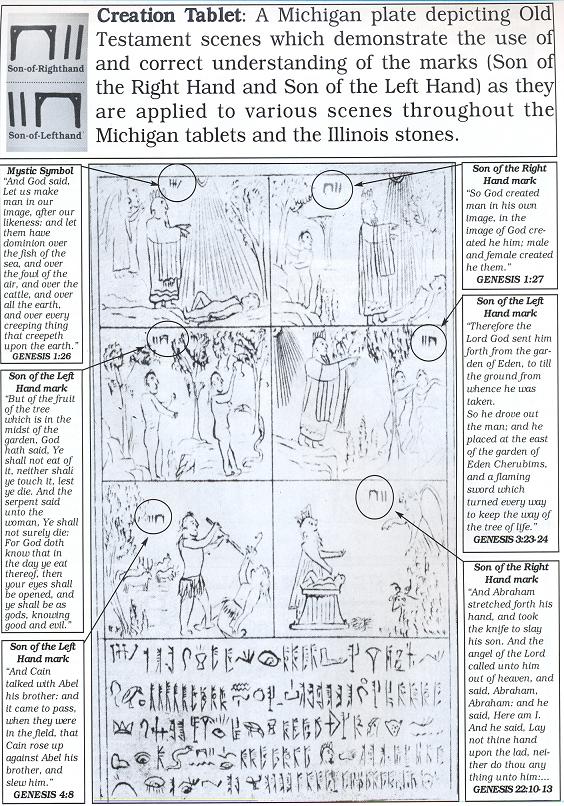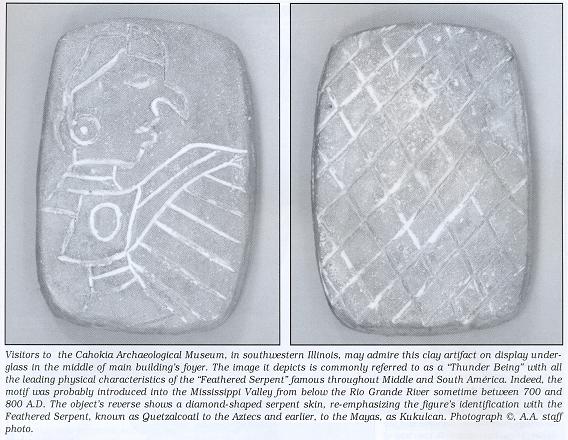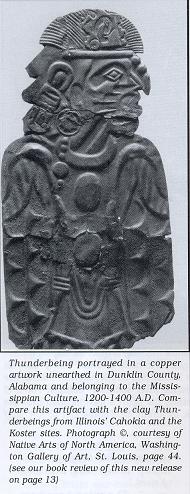CHRIST IN NORTH AMERICA? – (II)
Enter Burrows Cave
IN 1982, a discovery apparently unrelated to the Michigan tablets was alleged to have been made by Mr. Russell Burrows of Olney, Illinois. He claims to have found a cave in the southern part of his state loaded with the treasures of foreign visitors who crossed the seas from the Near East, Europe and Africa about 2,000 years ago.
He claims the site is also a rich repository of stone records belonging to some unknown people who possessed a high level of culture. I have known Mr. Burrows since 1993, and compiled a photographic library of some of his items, which number over 2,000 such stones. I personally examined about half of them, and have concluded they are authentic artifacts. Although he refuses to divulge the location of his cave, the sheer number and sometimes fine workmanship of the artifacts he allegedly took from the site tend to support their identification as genuine artifacts.
Even so, many of my fellow diffusionists have condemned the Burrows Cave finds as part of a hoax. Admittedly, the tangle of frustrating obstacles, legal and otherwise, preventing any kind of access to the location’s whereabouts have disenchanted very many investigators. But the full story of Burrows Cave, while yet to be told, is gradually unfolding with the gradual release of objects never before seen, and someday we may learn everything there is to know about this site. There may be a parallel here with the Dead Sea scrolls, discovered in 1948. Even now, a complete accounting of this find has still not been disclosed to the public.
Mr. Burrows telephoned me two years ago to say that he had purposely withheld some inscribed stones from sale because of the imagery they featured; namely, identifiably Christian scenes, mostly Old Testament. He was uncomfortable with these items, because he feared critics would use such obvious themes to further debunk his discovery. Mr. Burrows knew some Indians had knowledge of Old World traditions and Old Testament stories. But what concerned him was, as he put it, “the Jesus stones.”
At my request, he sent me photographs of them, and I was able to compare their images of evidently Old Testament themes with similar representations found on the Michigan tablets. I was astonished to notice that both sets not only featured scenes of Jesus Christ, but also the same “Mystic Symbol.” The same symbol appears in southern Illinois 62 years after the last published information concerning the Michigan mound builders using this identical mark. Approximately 20,000 to 30,000 Michigan artifacts were excavated from 1848 to the 1920’s, compared with the 6,000 to 7,000 Burrows Cave stones of southern Illinois removed between 1982 and 1986. These fundamental facts render any possibility for either collection being a hoax extremely remote, if not impossible.
The predominant glyph found on the Burrows Cave objects is the so-called “Helios symbol,” coined by epigrapher, Paul Shaffranke. Even this important character is found in conjunction with the Michigan symbol to suggest some type of inter-action between these two otherwise distinct groups. Maybe these glyphs have the same meaning. There appear to have been vital differences between these two groups of ancient Americans: non-Christian imagery dominates the Burrows Cave stones.
Still, there are legitimate doubts among our own diffusionist supporters concerning these “Christ stones,” due largely to some relatively minor variations in the placement of glyphs, together with the anomalous appearance of a particular symbol on the Michigan objects. Clearly, much work still needs to be done in any comparisons of these two diverse collections. But the evidence of the Michigan Tablets and Burrows Cave stones suggests that some fundamentally important culture-bearer visited our Western Hemisphere in pre-Columbian times. Was it actually the Christ? Or one of his disciples? Whatever his true identity, the arrival of this person left a deep impact on the tribal memories of Native Americans. Their “Yod-hey-vah” is remarkably similar to the biblical Je-ho-vah who seems to be portrayed throughout the Michigan plates.Was the East Star Man and Peace-Maker known to so many indigenous North American tribes really Jesus Christ? Perhaps the imminent translation of the Illinois and Michigan artifacts will answer that question. Following is a partial listing of the oral traditions of the Dawn God, Peacemaker, East Star Man, the Pale One, etc., from He Walked the Americas, by L. Taylor Hansen, Legend Press, Amherst, Wisconsin, twentieth printing 1994, @ with permission —
“Tribes of Oklahoma territory:
Today the name of Oklahoma, translated from the native language, means the Land of the Red Man. Here was a large and powerful city, whose crests showed an interesting history, and to this metropolis came the Healer. Here He once more changed the temples, chose from the priesthood His twelve disciples, and lectured to all the people…He told them that He was born across the ocean, in a land where all men were bearded. In this land He was born of a virgin on a night when a bright star came out of the heavens and stood over His city. Here, too, the heavens opened and down came winged beings singing chants of exquisite beauty… To them he was known as Chee-Zoos, the Dawn God, ..for well they know He watches over them, and that when their Journey here is over He will meet them in the land of Shadows, for such was His sacred promise.
From the Mississippi Tribes:
For the region of the Mississippi during the golden days of the Healer, Decoodah palnts us a fairly clear picture. Those we now call the Great Mound Builders, were tribes speaking the word-:family and branches of the Algonkin language. These were the Ancients of the country. In the days of the Great Mound Builders, these mounds marked the sites of the cities. The mounds were a sort of writing, a manner of recording passing history, a royal marriage, a dynasty ended. They were to be read from the inside outward, and about them swirled the cities. One had an even longer history than the modern town of London. The mounds were probably faced with lumber and then painted in brilliant colour, perhaps to resemble those of the Mayans with whom they seemed to have some commerce. In fact that commerce may have been extensive since there was much mining in Michigan.
To this happy and peaceful land came the Great White Robed Master with His sea-grey eyes and His golden sandals. Here too, we find the only relics probably touched by his hands or possibly fashioned under his personal direction.
In the Spiro Mound in Oklahoma, opened carefully in the practiced manner of all university excavations, was found the symbol of the hand with the great T-Cross through its center. There has also been recovered much pottery with winged beings not unlike the angels singing.
In the Indian mound of Pittsfield was found three pages of parchment now held in old Harvard, upon which were quotations from the Old Testament, written in Archaic Hebrew.
About eight miles southeast of Newark, the father of Bancroft, Indian recorder of untold legends, speaks of finding the only engraved stone pictograph of the white-robed teacher. About His head, in Ancient Hebrew were the words of the Ten commandments. His hair and beard are well pictured as well as His flowing robe…
How many other mounds have been plowed and leveled, and their contents scattered which the Red Men held as holy, planting trees of the sacred cedar upon them to keep them safe through two millennia? True the invasion of the Serpents from perhaps 700AD. onward, coming up the Mississippi in their long snake-painted dugouts, carrying their sacred fire, brought an end to peaceful living, and brought with them war and pillage and the priesthood of the Sacrificers. Yet they turned away from the hills of cedar, seeing the symbols of the Healer.
Eastern Tribes speak:
The Algonkin of the Eastern Seaboard, when asked how they got their name for the Dawn Light, say that it was the name of the Pale One. They would not give Him their own name, as He had asked them, for to Him names meant nothing and He allowed each tribe to name Him. They asked instead His name in childhood when He lived across the ocean. The name He gave them was a strange one, hard to say in their liquid language, so today they try hard to say it: Chee-Zoos, God of the Dawn Light.
The Algonkin of the Great Lakes remember well the pale Great Master. The Chippewa say He gave them many medicine lodges whose signs and symbols are secret, fashioned from those across the ocean, and even today they hold this secret know1edge.
Even the proud Dacootah, they of the Turtle Totem, leading north the line of Serpents, often their age-old migration, recall in long-lost adoration the sacred name of the pale-faced Healer.
“It was long ago that we knew Him. He gave to us our rite of baptism, many of our lodges, and our rites of purification. When He came to us the days were warmer; the sun cast down shorter shadows. Well do we remember how He foretold the coming of the white man, and other predictions; We have backslid from His teachings, but to Him we dance the Sun Dance. We remember Great Wakona well.”
Besides the shores of Mishee-gahme-gahme (Lake Superior) is the forest still called Sacred, in the state called Michigan….let us speak of the Prophet.
“He was bearded, and pale of feature-without doubt a White Man. His eyes were as grey-green as still green water, and just as changeable in their colour. He came to us one day at dawning and the light touched His hair with the sheen of red-gold- until it shone like newly-mined copper. Yet He was not as the men of your people. This one was a god, with high soul-stature. If He touched a man who was wounded, that one became healed.
 His robe was long and white down to the hemline which almost hid His golden sandals. Everyone wished to make Him white robes, for then He would leave behind the old ones, and all that He touched was enchanted with His god-like power of healing.”
His robe was long and white down to the hemline which almost hid His golden sandals. Everyone wished to make Him white robes, for then He would leave behind the old ones, and all that He touched was enchanted with His god-like power of healing.”
“…He came alone. He organized the churches, changed the temples, taught the priesthood. Some say He taught them a secret language with certain signs of greeting. I know not.”
“…He came to us when we had cities more than a thousand winters before the days of the Black Robes and the Long Knives…
“… The ruins have been scattered by White Men.”
“…The city which we call sacred is not far from here. Its history is longer than that of England’s London…”
“…Once we had books and priests to read them, but those were times long distant in the past. Books are of stuff which can be swept to oblivion. Since then we have placed our stories in the chants of our people, but now even these are being forgotten…..”
“Coming North from our Capitol, City, where the Mississippi meets the Missouri, in the long-boats of the traders, the Prophet made His journey toward the City we called Sacred. This was an ancient metropolis. Before we built its Mound of Extinction. after the Great Civil War of the Turtles, ninety-six dynasties of rulers had lived their long and eventful history. Like the Capitol, it too…had buildings built upon great crests… This city was called Sacred because it was in the center of the Cross of Waters from whence ran the rivers to the Four Oceans. East to the Sunrise ran the waters, and Northward to the Sea of Dancing Lights; to the West beyond the Great Divide the waters ran to the Sea of the Sunset, while the Missouri and Mississippi ran to the Southern Sea, the Sea of the Karibs… to this, the City of the Great Cross of Waters, up the river called Father of Waters, one golden morning came the Healer…The streets were covered with flowers strewn in homage on the path before Him as He walked toward the Temple. Greatly beloved now was the Pale God, known as the Lord of Wind and Water. His every move bespoke His kindness; His very touch revealed His divinity; and before Him all the people bowed down. Through the rows of worshippers He moved to the Temple, in quiet solemnity, holding up His hand in blessing-that hand with the strange palm-marking, for through it was engraved the True Cross which He had taken as His Symbol. There at the Temple He abode among us, though He often rode away with the merchants, or more often walked to distant villages, holding in His hand His great staff and stopping to speak with all the people, from the aged to the children.”
Even non-religious scholars recognize Jesus of Nazareth as an historical figure. But did he actually arrive in the Americas? The evidence for at least his followers establishing an important, even populous outpost in the North American Midwest, however, is rich with artifacts from both Michigan and Illinois. Moreover, the same recurring theme may be traced to the pre-Columbian peoples of North, Central and South America, implying that the culture bearer they memorialized was a real person. In rejecting such evidence, arbitrarily dismissing both the Michigan Tablets and Burrows Cave stones as “fakes,” persistent questions about the Christ-like visitor grow even more difficult to understand.
In the New Testament, Christ refers to other people and places he must go when He says:
“And other sheep I have, which are not of this fold: them also I must bring, and there shall be one fold. and one shepherd.” – King James version, John 10:16.
When did He go and visit these other people? If one concludes that there is something to the legends and stories of the inhabitants of Native America, then their visitor begins to bear a certain resemblance to Jesus as He is depicted in the New Testament.
In Fair Gods and Feathered Serpents, author T. J. O’Brien writes:
“One might argue, if Christ did not come here, how does one explain the religious use by New World natives of vestments, the cross, chants, rituals, incense, ceremonial objects. infant baptism, and great works of religious art: statues and paintings, also identified with Christianity? “
References:
Annals of the Cakchiquels. Title of the Lords of Totonicapan, published by University of Oklahoma Press. Norman. OK. 1953, Translated by Della Goetz
Book of Mormon, published by The Church of Jesus Christ of Latter Day Saints, 1987
Christ in North America, published by Resource Communications Inc., Tigard, OR, 1963, Delbert W. Curtis
Fair Gods and Feathered Serpents, published by Horizon Publishers, Bountiful, UT, 1997, Professor Terry O’Brien
Gospel of the Great Spirit, published by Morning Star Pub, Zion. USA. 1990. Joshua M. Bennett
He Walked the Americas, published by Legend Press, Amherst, WI, 1963. L. Taylor Hansen
History of the Ojibwa People, published by Minnesota Historical Society Press, St.Paul, MN. 1984, William W. Warren
Holy Bible, King James Version, Old and New Testament, published by The Church of Jesus Christ of Latter Day Saints, 1987
Ancient American Volume l, Issue #5, Stone, Clay, Copper, Archives of the Past, March/April 1994, The Mystic Symbol Demystified, David A. Deal
Ancient American Volume 2, Issue #9, Inca Stone, March/April 1995, The Mystic Symbol Demystified, Kenneth Moore.
References:
Annals of the Cakchiquels. Title of the Lords of Totonicapan, published by University of Oklahoma Press. Norman. OK. 1953, Translated by Della Goetz
Book of Mormon, published by The Church of Jesus Christ of Latter Day Saints, 1987
Christ in North America, published by Resource Communications Inc., Tigard, OR, 1963, Delbert W. Curtis
Fair Gods and Feathered Serpents, published by Horizon Publishers, Bountiful, UT, 1997, Professor Terry O’Brien
Gospel of the Great Spirit, published by Morning Star Pub, Zion. USA. 1990. Joshua M. Bennett
He Walked the Americas, published by Legend Press, Amherst, WI, 1963. L. Taylor Hansen
History of the Ojibwa People, published by Minnesota Historical Society Press, St.Paul, MN. 1984, William W. Warren
Holy Bible, King James Version, Old and New Testament, published by The Church of Jesus Christ of Latter Day Saints, 1987
Ancient American Volume l, Issue #5, Stone, Clay, Copper, Archives of the Past, March/April 1994, The Mystic Symbol Demystified, David A. Deal
Ancient American Volume 2, Issue #9, Inca Stone, March/April 1995, The Mystic Symbol Demystified, Kenneth Moore.
Courtesy: Ancient American Magazine





